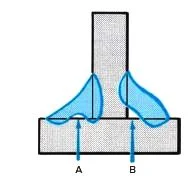Common welds and weld-related defect
 |
| weld |
A weld dissection is any blockage in normal
The flow structure of a weld. barrier: May be found in the physical, mechanical, or metallurgical characteristics of the material or weld.
If discontinuity exceeds the acceptance criteria being used,
it becomes a defect. There is an imbalance in all metals, heat-affected areas,
and welds. The heat-affected zone (HAZ) is the base metal next to the weld that
did not melt but was hot enough to change its mechanical properties or its
microstructure properties. Since all metals are crystalline structures,
blockages at each grain boundary indicate an interruption in the normal flow of
the material. But size, location, extent, and other factors must be applied to
see whether the product is fit for a purpose. When a defect is indicated, it
means that the defect exceeds the allowable limits of the applicable code or
specification.
Fillet weld profile
 |
| Fillet weld profiles |
Flat and concave fillet weld profiles are considered
desirable. shows a little
The convex profile is also acceptable. Thus we are reminded
again that the welder has to
Try to avoid excessive convexity. Convex fillet welds are
acceptable, provided the convexity is
within the limits indicated by
Fillet welds with overlap, a protrusion of the weld metal
beyond the weld
Toe and base metal. This can be compared to applying a wad
on the surface of the chewing gum. when the load is applied
glue, it will peel off the surface. the welded joint will
act the same way under load, and the result will be a weld
Failure. It is clear that overlap should be avoided if we
To prevent peeling of weld metal when loaded
is applicable. Joint failure is certain when there is
overlap
located in the weld. This is a serious flaw and should be
Avoid This may be due to low welding current, slow
tripping, or improper electrode manipulation.
Fillet weld with insufficient leg A reduction in leg length, means a reduction in the size
fillet weld. If the demands of a joint require a fillet of a
certain size, any reduction in that size results in a weld that does not have
the physical properties required for safe operation. The result of failure is
certain. This defect is usually caused by improper electrode angle and faulty
electrode manipulation. In addition, these defects in welding technology can
occur with very fast travel.
Fillet welds with incomplete fusion This defect are usually
found at the root of the weld and on the plate surfaces (fusion faces),
Incomplete fusion is usually caused by welding with too low current, improper
speed of travel, and/or improper electrode Is. cunning. When these conditions
are present during welding, slag inclusions and porosity (gas.) may occur in
the weld metal deposited.
trap).
Fillet welds with various other anomalies
represents a number of potential defects that may be
encountered in the base material or
weld bead.
Porosity is a cavity-type imbalance (referred to
as the form of pores) formed by the trapping of gas during
solidification. The dissections are circular and may be elongated.
contamination of filler metal or base metal or
Discontinuation in single-pass double fillet welds at T-joint.
Evenly dispersed and piping porosity.
1b. Cluster porosity. and aligned porosity.
2a. Lava included.
4. Incomplete fusion.
5. Undercut.
7. Overlap.
8. Lamination.
9. Pollution. 1
0. Sew and Lap.
12a. Longitudinal
crack.
12b. transverse crack. 12c. pit crack. 12d. Throat crack.
12E. Toe crack. 12f. Root crack. 12 grams
The underbred and heat-affected zone (HAZ) cracks.








0 Comments